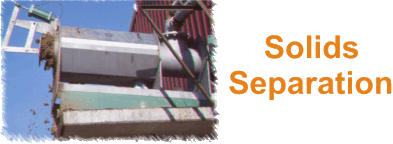
back to: Research Program Information

Mechanical solids separation devices: Link provides data and reports of separators tested with The University of Tennessee standard testing protocol. Development of a Standard Method for Testing Mechanical Manure Solids Separators: Paper presented at 2003 ASAE International Meeting in Las Vegas, NV. July 27-30, 2003. Optimization of Phosphorus Partitioning in Dairy Manure Using Aluminum Sulfate with a Mechanical Solids Separator: Paper and POSTER presented at the 2003 ASAE International Meeting in Las Vegas, NV. July 27-30, 2003. Performance Testing and Nutrient Partitioning Poster: Poster and paper presented at the International Symposium Addressing Animal Production and Environmental Issues. Oct. 3-5, 2001. Research Triangle Park, Raleigh, N.C. Why Develop a Common Test for Mechanical Solids Separators? Confined animal production systems utilizing hydraulic-flush manure collection and transport systems use different methods of solids separation to achieve an effluent low enough in total solids to be recycled as flush water. Mechanical solids separators provide one method of solids reduction for flush systems. The performance of mechanical manure solids separators can vary dramatically with different total solids input concentrations. To properly size and install mechanical manure solids separation units, the separatorsí performance characteristics must be known for the manure slurry found at the farm in question. The results of these performance tests provide information a planner can use to estimate the expected through-put of material, the resulting mass of solids to be removed and the total solids (TS) content of the recovered solids expected from a given manure slurry. This is important information when sizing process sumps and solids storage areas; it is critical to selecting a unit that can be operated in the time frame desired by the producer. The nutrient partitioning data can be used by nutrient management planners to estimate the mass of nutrients remaining with the recovered solids. |